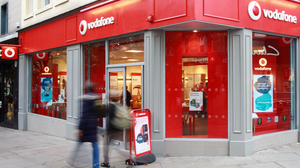Nokia CEO bids to revive loss-making mobile unit amid sale rumors
After setbacks in North America, Nokia's mobile business group slid to its first operating loss since CEO Pekka Lundmark created it.

When he succeeded Rajeev Suri as Nokia's boss in August 2020, Pekka Lundmark moved quickly to restructure the ailing Finnish kit maker. Upset by supplier problems and some poor decision-making – as well as the difficulty of merging with Alcatel-Lucent after the €15.6 billion (US$16.7 billion, at today's exchange rate) deal it did in 2016 – Nokia had previously fallen behind Ericsson and Huawei in 5G. Under Lundmark, the mobile business, responsible last year for 44% of sales, became a standalone unit, making it more accountable to investors. Today, they will have noticed, it suffered its first quarterly loss.
That was prompted by a massive 39% year-over-year drop in mobile sales for the first quarter, to less than €1.6 billion ($1.7 billion), after the loss in December of a mobile contract with AT&T, one of Nokia's biggest customers, to Ericsson. But the Swedish company has also watched its sales dive as telcos slash spending. Dell'Oro, a market research firm, expects the market to shrink 4% this year. Earlier this week, Börje Ekholm, Ericsson's CEO, described that forecast as "optimistic."
On a constant-currency basis, the mobile revenue decline of 37% at Nokia was evidently much worse than the 19% fall at Ericsson's equivalent unit. Much of the difference seems down to what Nokia described as "lower market share at one North American customer." Nokia has been responsible for one third of AT&T's mobile network, but it will ultimately be phased out and replaced by Ericsson, which already had the other two thirds.
Regardless, North American customers that previously gorged on supplies have seen little need in the last year to replenish inventory. The pace of a 5G rollout in India has dramatically slowed. Denied the opportunity to consolidate, European telcos still underinvest in 5G, complain vendors. After managing a €137 million ($146 million) mobile operating profit for the first quarter of 2023, Nokia slid a year later to a €42 million ($45 million) loss.
Saved by licensing
The shrinkage, unfortunately, was not confined to mobile. At the network infrastructure business group – housing fixed, optical and Internet Protocol activities – sales were down 26%, to less than €1.7 billion ($1.8 billion). An engine of sales growth during Lundmark's first years in charge, it registered a 42% fall in operating income, to €82 million ($88 million). At cloud and network services, meanwhile, revenues dropped 14%, to €652 million ($696 million), and losses widened 35%, to €27 million ($29 million).
The headline company performance, however, benefited from some lucrative deals at Nokia Technologies, the brand and technology licensing unit that books all sales as gross profit. Revenues there surged 213%, to €757 million ($808 million), and operating income rose 342%, to €658 million ($703 million). This all fed into a 46% increase in Nokia's overall net profit, to €501 million ($535 million), with company sales down a fifth, to €4.67 billion ($5 billion).
Without licensing deals, essentially, Nokia would have looked in far worse shape. Much like Ericsson, it has responded to the market contraction by announcing a fresh wave of cuts. Having already cut 16,000 jobs since 2016, the year of that Alcatel-Lucent deal, Nokia last year said up to 14,000 roles would disappear, and no fewer than 9,000, by the end of 2026. The aim is to save between €800 million ($854 million) and €1.2 billion ($1.3 billion) in annual expenses.
Lundmark's latest expectation, disclosed on a call with reporters earlier today, is that Nokia will cut around 11,500 jobs and end up with a workforce of approximately 74,500 people at the end of 2026. "We are progressing toward this target and currently looking at somewhere around the midpoint of that range," he said when asked by Light Reading if there is now more certainty about the ultimate size of the company at the end of the program. "That will then finally depend on the development of the market situation."
'Active portfolio management'
What of more radical steps? Lundmark's efforts to decentralize and give business groups more independence and autonomy would make the disposal of assets much easier. And there has long been speculation about a possible acquisition of Nokia's mobile business by an American investor. Certain US authorities seem determined to have a major 5G equipment maker under US control. But efforts to nurture homegrown alternatives through open RAN – a concept intended to aid specialists – have been largely futile.
While he declined to comment on those rumors, Lundmark did allude to the divestment of smaller units in 2023. "We have said that we are continuously doing active portfolio management – you have seen some our recent moves that we did last year," he said. Disposals included the €185 million ($198 million) sale of a device management business to Canada's Lumine Group and the earlier transfer of about 350 employees working on cloud platforms to IBM-owned Red Hat.
Even so, there is little sign today that a more dramatic sale is under serious consideration. "We are pleased with the strategy that we have in place in mobile networks," said Lundmark. "We have a strong value proposition there, we have increased our market share in recent years, and we have a good strategy to deliver value to our shareholders."
Under the leadership of Tommi Uitto, the mobile business group certainly appears to be in better shape now than it was in 2019. Market share losses back then seemed a consequence of 5G product problems. Let down by Intel on the delivery of 10-nanometer basestation chips, Nokia had resorted to field programmable gate arrays (FPGAs), a more expensive type of component, and its competitiveness suffered. But Uitto subsequently introduced the well-regarded Broadcom and Marvell Technology as chip suppliers alongside Intel, and the FPGAs have now been replaced. Outside China and the US, Nokia's market share has recently grown, say independent analysts.
AT&T's controversial decision, according to numerous commentators, was driven by its desire to have a single vendor providing a unified underlying platform across the entire network. Whatever that telco says about introducing other radio unit suppliers next to Ericsson, few sizeable options are available. Telco executives who spoke on condition of anonymity with Light Reading at this year's Mobile World Congress view the arrangement with considerable skepticism.
Better days ahead?
Lundmark, meanwhile, is banking on an improvement in market conditions later this year. Order intake has improved, he said in his introduction to the latest quarterly report, "meaning we remain confident in a stronger second half and achieving our full year outlook." Guidance is for a comparable operating profit of between €2.3 billion ($2.5 billion) and €2.6 billion ($2.8 billion).
But that order activity appears to be happening mainly at the network infrastructure group. In mobile, the full-year outlook remains relatively bleak, even if the second half brings some improvement. "The market has been really, really weak, which is not a Nokia issue," said Lundmark, in his detailed answer to that question about a sale of mobile assets. "It is an industry issue."
Like Ericsson's boss, he hopes that traffic growth will eventually leave operators with no choice but to open their wallets. "It has to be a matter of time before operators again will have to start investing, and, once that happens, we will be in a strong position," he said. Many will pray he is right.
About the Author(s)
You May Also Like












